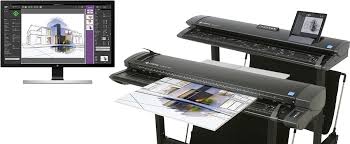CIS vs CCD sensor technology: which would be better for your next scanner?

When you are next in the market for a large-format
scanner, you are likely to find the decision-making process easier if you
are aware of the fundamental differences between the two commonly used types of
sensor technology – CIS and CCD.
Those initialisms stand for Contact Image Sensor and Charge-Coupled
Device respectively.
So, let’s set out the vital things to know about these respective
technologies, including their advantages and disadvantages, to help you reach a
well-informed buying decision.
Why should you opt for a scanner incorporating CIS tech – and why
should you not?
It is in scanners where CIS sees its predominant use as a technology. It
involves the placement of an array of small light-sensitive elements very close
to the object or document that the user wishes to scan.
The main “pros” of purchasing a large-format scanner using CIS sensor
technology include:
- The thinness and light weight of CIS
sensors, which enables them to be incorporated into especially slim
and portable devices.
- The relatively little energy that CIS
sensors need. Such lower power consumption has led to CIS sensors
being used in battery-powered devices.
- The suitability for the scanning of
documents. A document is, of course, a flat object. Sure enough, CIS
sensors are well-suited to sheet-fed and flatbed scanners in which the
object to be scanned is in close proximity to the sensor.
- The ability to quickly capture image data
compared to CCD sensors.
There are, though, also some reasons why you might not be so
inclined to choose a large-format scanner that draws upon CIS sensor
technology. These include:
- The suitability being restricted to
direct contact scanning. In order for a clear image to be captured,
the CIS sensors need to be in direct contact with the scanned object.
- The limited depth of field. If an
object is slightly raised from the scanning surface, it may produce a
blurrier image the further away it is from the platen glass.
- The restricted colour range. Compared
to some CCD sensors, CIS sensors cannot be depended on to provide such an
impressive level of colour gamma and dynamic range.
In what circumstances, then, might CCD tech make more sense for your
next scanner?
If you opt for a higher-end large-format scanner, the chances are that it
will incorporate CCD sensors, which also see widespread use in professional
cameras and medical imaging devices.
An array of light-sensitive pixels is used in these sensors, with these
capturing data and then transferring it through a complex process, to produce
high-quality imagery.
CCD sensors, then, offer such benefits as:
- Formidable image quality. You can
generally count on a large-format scanner using CCD tech to give you a
wider colour range, dynamic range, and heightened detail compared to a
device based on CIS tech.
- Better performance in low light
conditions. CCD sensors’ greater sensitivity to light means they can
capture good images even when it’s dim.
- Improved depth of field. Even if
objects to be scanned are not in direct contact with the sensor, as long
as the scanner is using CCD tech, convincingly detailed images can still
be captured of them. This helps make a CCD scanner a flexible device.
So, which type of sensor should you look for in a large-format
scanner?
Ultimately, CCD and CIS are two distinct technologies, designed to fulfil
different purposes. So, the decision as to which is “best” will depend on your
particular needs.
In summary, however:
- If you are looking for a cost-effective
solution for the general scanning of documents, such as CAD and line
drawings, CIS will typically be the best choice. It offers
affordability and low power consumption, in addition to lending itself
well to smaller and more portable devices due to the light weight and
thinness of the sensor.
- If, on the other hand, your intended
applications call for particularly high-quality imagery and you will be
scanning items with deeper texture – in other words, not just “flat”
objects – the higher image quality, wide colour gamma, and broad depth of
field offered by CCD is likely to make it the optimal choice.
It should be noted, of course, that one CCD scanner will not necessarily
be exactly the same as another CCD scanner in its performance and results, and
much variation can be seen among CIS devices, too.
Different scanner manufacturers can also differ in terms of how their
devices process and optimise scanned imagery to create the final image output.
Talk to the experts at Prizma Graphics to help you come to a decision
As wide-format specialists here at Prizma Graphics, we would be pleased
to discuss your individual requirements and to provide tailored advice.
We can also arrange scanning sample tests and demonstrations, if doing so
would help you decide on the best scanning solution for your needs.
Whatever your particular situation may be as you seek out the most
suitable large-format scanner, please feel free to contact
us by email, or to give us a call on 01296 393700.
